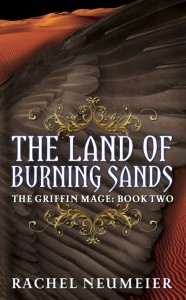When Characters Surprise You
 When I was about two or three chapters into Land of the Burning Sands, I sent a note to my agent to ask, facetiously, whether she could provide a role for the leading female character to play besides merely serving as the love interest in the story. If I didn’t come up with something important for that character to do, I said, I’d write her out of the book entirely.
When I was about two or three chapters into Land of the Burning Sands, I sent a note to my agent to ask, facetiously, whether she could provide a role for the leading female character to play besides merely serving as the love interest in the story. If I didn’t come up with something important for that character to do, I said, I’d write her out of the book entirely.
As I recall, Caitlin said she had great faith in me. Very comforting!
But the fact is, I had absolutely no idea what Lady Tehre Amnachudran might be like until the first time she walked ‘on stage.’ Here’s how that scene went:
Tehre Amnachudran had nothing of her father’s visible kindness or her mother’s comfortable warmth. She looked . . . not precisely stern. But if she had been tall and stately, she might have possessed an intense, striking beauty that went beyond ordinary prettiness. Because she was small and delicate, she merely looked high-strung.
. . . She gave Gereint a mistrustful look, but waved for him to accompany her. “You’re a maker? I’m working on this problem having to do with the elongation of cracks in large structures. Of course, when you’re working with masonry, stone breaks when you subject it to remotely applied tension, I’m sure you know that, but what I can’t see is how the cracks shift from slow, sporadic propagation to sudden catastrophic propagation. Do you work with masonry?”
Now, actually, my background is in biology. And I can handle chemistry pretty handily, at the introductory level. But, you know what? Physics, not so much. Yet here I was, not only faced with needing to kind of fake my way through the physics of materials and engineering, but to do it in terms of Casmantian ‘natural philosophy’, not modern physics!
I love Lady Tehre. I really do. I get a tremendous kick out of her. But I never again expect to have to do so much research per line with any other character ever. I still have tons of notes about wooden bows and catapults, and stone walls and arches, and cast iron versus wrought iron – way more than I ever used. Want to know the technical difference between stress and strain? Hey, now I can explain it! At least sort of!
This is because I have a copy of the eminently readable book Structures: Or Why Things Don’t Fall Down. This is a delightful book I got some years ago, by JE Gordon, who was a professor of materials science at the University of Reading*. Gordon worked Shakespeare quotes and bits of poetry into his explanations of why stone lintels break and how walls fall over – I’m pretty sure it’s the only book on physics I will ever read for fun. When I first read this book, years ago, I never for a moment thought Gordon’s explanations of structures and how they breaks would actually come in useful! Honestly, you just never know.
I sure didn’t have a clue, until the first time Lady Tehre walked on stage. And then, naturally, everything turned out to hinge on her particular genius. Sometimes characters really do take off in totally unexpected, astonishing directions.
* Any mistakes Lady Tehre makes in the course of events are not Gordon’s fault. Nor are they my fault. Those mistakes were deliberately inserted because Tehre’s understanding of the physical principles with which she is working is supposed to be incomplete. Anyway, if you happen to be a materials scientist and notice an error, well, that’s my story and I’m sticking to it.
